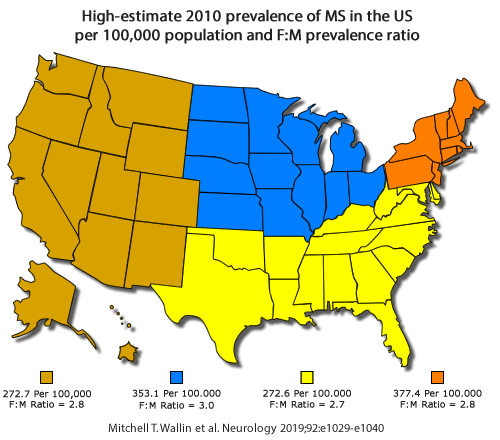 The revised 2010 US MS prevalence data.
The revised 2010 US MS prevalence data.The United States is 13th on the United Nations Human Development Index, as measured by education, health and life expectancy. Unlike many other nations the USA lacks a unified health data system capable of providing standardized public health data that is readily shareable across the governmental, industrial, health professional and consumer domains. The lack of a standardized data requires researchers and public health planners to estimate incidence and prevalence of MS. These estimates may not reflect the actual toll of the disease.
 The revised 2010 US MS prevalence data.
The revised 2010 US MS prevalence data.
Using pooled health claims datasets from a variety of public and private sources, as well as uninsured cohorts, Wallin M., et al. (2019), estimated the 2010 prevalence of MS in the US adult population to be 309.2 per 100,000 which represented 727,344 cases. During the same time period, the MS prevalence was 450.1 per 100,000 for women and 159.7 for men (female:male ratio 2.8). The estimated 2010 prevalence of MS was highest in the 55- to 64-year age group. A US north-south decreasing prevalence gradient was identified (Wallin M. 2019).
Assuming that the factors contributing to the 2010 estimated MS prevalence have persisted, the authors projected an upper limit of 913,925 U.S. persons living with MS in 2017 (Wallin M. 2019).
Age of onset: MS can occur at any age. Most people experience their first symptoms of MS between the ages of 20 and 40 (NINDS 2019).
Life expectancy: The MS patients have on average a 7-year shorter life expectancy than the general population (Lunde HMB. 2017).
Gender: MS occurs more often in women, at a ratio of 3.0 to 1 in the Midwest states (Wallin M. 2019).
Race: Caucasians, especially those who were born in temperate areas of the world, such as North America and northern Europe, are more affected by MS than are: Native Americans, African-Americans, Hispanic-Americans, and Asian-Americans.
Geography: Geography is a factor in the incidence of MS. The occurrence of multiple sclerosis in the Northeastern states of America is 377.4 cases per 100,000 population compared to 272.6 per 100,000 in the Southern states. The frequency drops to 1 case per 100,000 population in equatorial areas. Some studies indicate that the prevalence is reversed in the southern hemisphere, where higher rates are found in the southernmost portions of that temperate zone. Growing up in an area of lower frequency and then moving to an area of higher frequency after the age of 15 years seems to retain the risk of lower frequency area. Moving from a lower frequency area before the age of 15 years confers the risk of the higher frequency area.
Heritability: The inheritance pattern of multiple sclerosis is unknown, although the condition does appear to be passed down through generations in families. The risk of developing multiple sclerosis is higher for siblings or children of a person with the condition than for the general population (GHR 2019).
Instant Feedback:
Finally, researchers have advanced various theories involving exposure to a bacterial or viral agent that sets the stage for MS. To date no infectious agent has been correlated with MS. There is also no evidence that MS can be transmitted from one individual to another.
Reference:
U.S. National Library of Medicine. Genetics Home Reference (GHR 2019) Multiple Sclerosis: Inheritance Pattern.
Retrieved 11/1/2019. https://ghr.nlm.nih.gov/condition/multiple-sclerosis#inheritance
Lunde HMB, Assmus J, Myhr K, Bø L, Grytten N. (2017). Survival and cause of death in multiple sclerosis: a 60-year longitudinal population study. J Neurol Neurosurg Psychiatry. 2017 ;88(8):621-625.
National Institute of Neurological Disorders and Stroke (NINDS 2019). Multiple Sclerosis Information Page. Retrieved 10/31/2019.
https://www.ninds.nih.gov/Disorders/All-Disorders/Multiple-Sclerosis-Information-Page
Wallin M T., Culpepper W.J., Campbell J.D., Nelson L.M., Langer-Gould A., Marrie R.A., Cutter G. R., Kaye W.E., Wagner L., Tremlett H., Buka S.L., Dilokthornsakul P., Topol B., Chen L.H., LaRocca, N.G. (2019) The prevalence of MS in the United States. Neurology Mar 2019, 92 (10).
© RnCeus.com